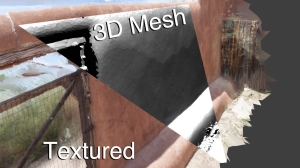Researching workflows for photogrammetry and reflectance transformation imaging is just part of the work we are doing on this project. The other part of our work is to test different equipment and software. One of the big decisions we have to make is in our 3D mesh editor. Once the photos have been captured for photogrammetry and after the photos have been taken into Agisoft’s Photoscan for processing, you should now have a 3D mesh. This 3D mesh is Photoscan’s best guess at what the actual object looks like. It is far from perfect and requires editing. Holes in the mesh might need to be filled or superfluous surfaces deleted. A building as large as Abiquiu has to be photographed over the course of several days. Each day is processed in Photoscan as a separate mesh. This creates many different individual 3D meshes that need to be cleaned up and joined together to create a single composite mesh. Initially we chose Meshlab as our mesh editor. It is free and open source, which is very important for two reasons:
1) Full disclosure of all data transformations. Any changes to the original pictures across all of the pixels in each picture is visible to us. It is open and free from secrets created by proprietary software. This makes the data transparent and ideal for scientific recording.
2) With open source we have the ability to apply our own scripts and transform it in ways that are specific to our needs. This frees us from the constraints place on us by proprietary software.
We discovered that there were features that were lacking in Meshlab that made editing and joining difficult and time consuming.
1) There is no undo button. Professional 3D mesh editors all share a non-destructive editing environment. Any changes made to Meshlab are final. If a mistake is made, it is necessary to reload from you last save point.
2) It is not well documented. There is an instruction manual, but there is not a very big community of users, or a large number of tutorials available. This makes learning the software difficult.
After researching various alternatives we decided that Blender was our best bet for mesh editing and joining. Blender is free, open source, cross-platform compatible, extremely robust, contains a wealth of documentation, and boasts a very helpful learning community. Since Blender contains so many features, there is a steep learning curve in getting proficient at mesh manipulation, but the time spent in learning the software is well worth it. Thanks to the Blender, we will soon be putting up some very high quality 3D meshes of the Abiquiu House on the blog!
So to be clear for those of you who are Meshlab enthusiast and are screaming at your computer “These guys are just noobs! Meshlab is awesome if you know how to use it!” Yes you are right, but that is exactly our point. We ARE noobs as are all of the people who will be using this software in their work. Blender does have a steep learning curve but there is plenty of help. We have yet to have a question about the software that wasn’t answered in print as well as with accompanying video tutorials.
So while we will keep a link to Meshlab on our equipment and software page, Blender is our recommendation for anyone editing meshes exported from Photoscan.





Pingback: Week 5 | Georgia O'Keeffe Imaging Project
Tom Burtonwood @tburtonwood and Liz Neely @lili_czarina Tweeted that he has had issues making interiors + exterior watertight. If we shhot the floor, this one of the roofless room is pretty tight! if we get 3d printable meshes, Tom would ❤ to c them!
We will get on that this week! The results for this coming week are going to be great.
acousticguru you are making some really nice arguments about why foss (free open source software) should be a PREREQUISITE for cultural heritage work. Especially this part :
“Any changes to the original pictures across all of the pixels in each picture is visible to us. It is open and free from secrets created by proprietary software. This makes the data transparent and ideal for scientific recording.”
It’s in the spirit of this talk about a game engine for cultural heritage (serious) games 🙂
Click to access AcropolisGamePlatform_orbitlab.pdf
Thanks for the positive feedback Alex, and thank you even more for directing me to that great article you wrote! It is fantastic. I had not heard of the concept of serious gaming. So not only can serious gaming be used for education, but also as a serious tool for conservators across the world to monitor conditions of structures, from Erechtheion Temple of the Athens Acropolis to Georgia O’keeffe’s Abiquiu home.
I highly recommend CloudCompare as mesh evaluation and editing program! It’s free and opensource: http://www.danielgm.net/cc/ We’ve completely abandoned MeshLab in favour of it.
George Bevan
Queen’s University
Thanks for the suggestion George. We will be sure to check it out. I can tell you now that the compare function would be VERY useful for our purposes.
George, Thank you for giving us the benefit of your experience. Cloud Compare looks to be really useful. Sounds like you and Queens have done some work with 3D imaging in preservation. Can we ask you to consider a guest blog post here on the GOKMIP blog site? It would be great to read your analysis of the practicality and applicability of these technologies for conservation and preservation! We’ll send you some Chile by way of compensation!
Sounds good to me! Drop me a line and I’d be happy to help out.
Great News, George! I’m (Dale) on the road right now but will compose an email and start the ball rolling. soon. Thanks!
Very good article! We are linking to this great post on our website. Keep up the good writing.